#Antarctic minke whale
Explore tagged Tumblr posts
Text

Antarctic minke whale "Balaenoptera" bonaerensis
Observed by justinhofman13, CC BY-NC
#Balaenoptera bonaerensis#Antarctic minke whale#Cetacea#Balaenopteridae#cetacean#whale#Antartica#Southern Ocean#Gerlache Strait
87 notes
·
View notes
Photo

Antarctic Minke Whale - Cortica River Upstream
Endless Ocean: Blue World, Nintendo Wii
i believe this part of the story was based on real-world events, where whales have mysteriously turned up (dead, unfortunately) in the middle of the jungle! i think there was one in the amazon a few years ago?
thank you so much for the submission!
Submitted by BBB
#eo photo submission#endless ocean#endlessocean#endless ocean blue world#endless ocean 2#endlessoceanphotos#nintendo wii#wii#antarctic minke whale#piraiba catfish#cortica river upstream
17 notes
·
View notes
Text


3 notes
·
View notes
Text
Everyone knows and loves the sweet songs of the humpback whale, but not many have heard the songs of other baleen whales. I wanted to share three of my favourites today:
First up we've got the bowhead whale: The jazz-like sounds of bowhead whales (youtube.com) (I don't know if jazz-like is an entirely accurate descriptor. One of these whales sounds like a heavy piece of metal getting dragged across a concrete floor).
Next up, the understated song of the right whale: Right Whale Underwater Sounds (youtube.com). While they lack the vocal range of a humpback, the right whale vocalizations have a similar peaceful, melodic sound to them.
Finally, scientists were perplexed for years by a number of strange underwater noises sounding remarkably like waterfowl. Known as the "bio-duck", this phenomenon was found to be caused by Antarctic minke whales: Balaenoptera bonaerensis "bio duck" (youtube.com). Minkes make a range of interesting noises including pops, trills, and a boinging noise like a spring!
#cetaceans#marine biology#marine conservation#marine science#humpback whale#right whale#bowhead whale#minke whale
17 notes
·
View notes
Photo
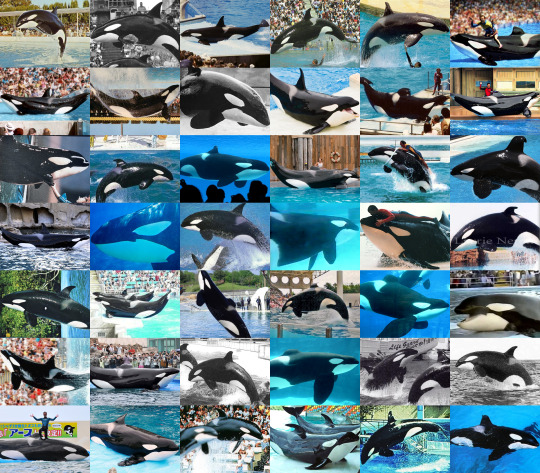
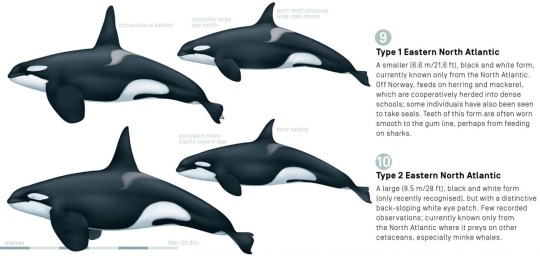

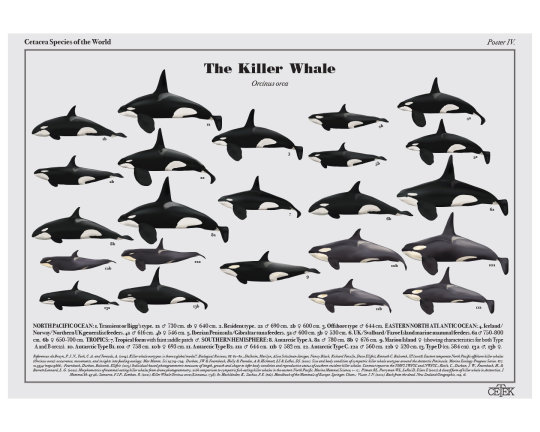

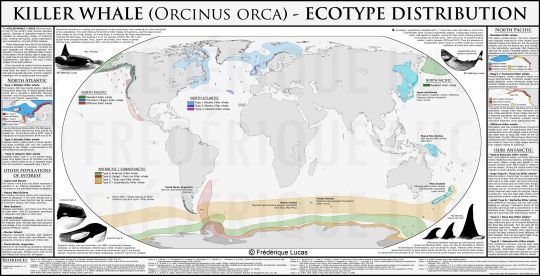

Icelandic whales and ecotype
I’ve seen some claims going around that the Icelandic whales displayed in zoos and aquariums for the past several decades are actually two different ecotypes, with some being “North Atlantic type 1″ and a few others being “North Atlantic type 2″.
I think this is completely wrong, and will show you why.
Above are an assortment of ecotype infographics.
As you can see, “type 1″ are the typical whale you’ll find off Iceland and Norway. They eat mainly herring and other small fish (though some individuals have been observed taking seals), and males typically range from 6.2-6.6 meters, females, around 5.5 meters.
They have clear saddlepatches, and tend to have eyepatches like this:

As the closeup of the map image (last image in the collection above) shows, “type 1″ orcas are also in turn split into type A and B. Type “1A”, if you will, follow exactly the range of where Icelandic whales were caught, and along the Norwegian coast (this eyepatch collage is of both Icelandic and Norwegian whales).
As all the other ecotype infographics show, “type 1″ live off Iceland, Norway, with a couple pointing out that they may range as far south as Scotland and Ireland.
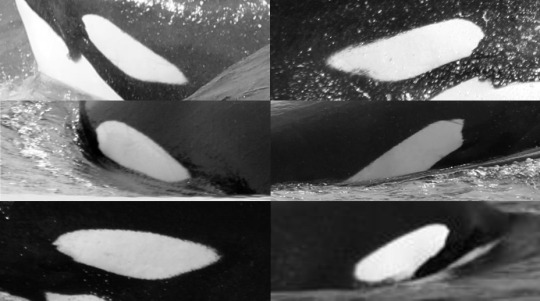
“Type 2″ on the other hand, is huge, one of the largest killer whales anywhere on Earth (after Antarctic type A). Males are 7.5-8.5 meters long, females 6.5-7 meters. They have distinctive downwards sloping eyepatches (like sad eyebrows, seen above), faint saddlepatches, are are very rarely seen, range around Britain, Ireland, the Faroes, and occasionally as far as Svalbard - not Iceland or Norway. They are mammal-eaters, specializing in minke whales as prey. Today, only a few of them remain.
The claim is then, that some of our Icelanders in human care are secretly, actually, type 2.
Let’s look at them. I have gathered all the whales caught in Iceland into a large collage, here split for ease of viewing. The only named whales I couldn’t get good enough images of were Canuck 2, Magnus and Benkei 2.
If the whale is still alive or died as an adult, I will provide measurements, if known.
I originally wrote descriptions for all the following whales, but it got tiring, repetitive, and too lengthy.

Kim, Gudrun, Kenau, Kandu 5, Hoi Wai, Kona 2, Winnie, Betty, Kahana, and Kasatka.
All of very typical “type 1″ looks.
Kim
Gudrun has no measurements available, but as can be seen when she lived at SeaWorld as a full-grown female, she was not large.
Kenau was caught with Gudrun. She was 5.5 meters long when she died at age 16.
Kandu 5. Interestingly, Orkid is the only whale in human care who has anything like the type 2 eyepatch, but she’s the daughter of Kandu who does not, and a Northern resident (Canadian) father who also did not. Kandu measured under 5.4 meters when she died.
Hoi Wai
Kona 2 was likely caught with Kandu 5, had enormous, distinct eyepatches, and she was 5.5 meters long at the time of death.
Winnie was caught with Hoi Wai as said, had a typical Icelandic eyepatch, and the same size and shape as other Icelandic females she lived with.
Betty was caught along with Katina, so they were likely pod mates.
Kahana was caught with Kasatka. She was particularly petite, measuring barely 5.1 meters when she died aged 15.
Kasatka was a mere 5.2 meters long, and looks nothing like a type 2 whale.

Shawn
Kotar was 17-18 years old when he died, and measured 6.4 meters at the time of his death.
Katina is a typical, squat and stocky Icelandic whale with large eyepatches. She is just barely 5.5 meters long.
Dzul-ha
Caren was just 10-11 years old when she died, and measured 5 meters long.
Kiska was a larger female at 6 meters. Large for a type 1, but nowhere near the 6.5-7 meter type 2 females.
Keiko was an average-sized type 1 male at about 6.4 meters.
King
Ulises is another average-sized type 1 male, at 6.4 meters.
Bjossa is another I can find no measurements of, but she was much smaller than Corky, who is 6.1 meters (a Northern resident). She looks typical of an Icelandic whale if a bit long. Looking at the top middle whale of my eyepatch collage, that whale looks just like Bjossa.

Finna was caught along with Ulises, Bjossa and Vigga, his pod mates.
Vigga was another stocky and short female with large eyepatches, notably smaller than her 6 meter Northern resident companion.
Nemo
Neptune
Ruka
Noni/Nootka was stocky and large female, at 6 meters, but with a bright saddle and eyepatches so commonly seen among Icelandic and Norwegian herring-eaters.
Freya was the only adult I could find who had a truly faint saddle patch (note that juveniles of all ecotypes tend to have faint saddles). She was also very long and slender compared to the typical, more stocky Icelandic female. She was however caught along with Kim 2 and Haida 2, and measured 6 meters in her late 20s. Her eyepatch is not type 2.
Haida 2 was, unlike her likely pod mate Freya, very typical in appearance for a type 1. She measured 5.2 meters at the age of 13.
Kim 2 was reportedly a large male, at 6.9 meters, just under Tilikum in size.
Nootka 4 (strange designation since she was caught one year after “Nootka 5″) was the same size as Haida.

Tilikum was the largest Icelandic killer whale in human care, reportedly at just under 7 meters, though I have also seen 6.7 meters (in 2016, shortly before his death). Even if he was 6.9 meters, that is indeed large for a type 1, but absolutely minute for a type 2, and he looks nothing like them.
Nandu
Samoa was 5.15 meters long when she died, with a clear type 1 eyepatch and saddle patch.
Junior
Bingo had interesting triangular eyepatches and a black line in his saddle, and measured 6.5 meters in his early 30s.
Patty
Kandu 7
Prince
Maggie
Oscar was an unusually small male, measuring only 5.8 meters at the age of 26.

Stella is very small, only around 5.2 meters long.
Ai
Ran
Sharkane
Tanouk measured 6.4 meters in his teens (meaning he would grow larger for a few years).
So that’s all of them, except for Canuck 2, Magnus, and Benkei 2.
Then, there is this:
You can stop calling North Atlantic killer whales type 1 and type 2
“The main issue with type 2 killer whales came from the small sample size (5 individuals)”
“In the meantime, Dr. Foote suggested we just drop the “type 1/type 2” classification for now.”
There is simply no basis to think any of the above 45 whales from Iceland are or were the “type 2″ whales, like John Coe.
58 notes
·
View notes
Text
Wings of Fire Dragon Guide, Part Three: RainWings and IceWings
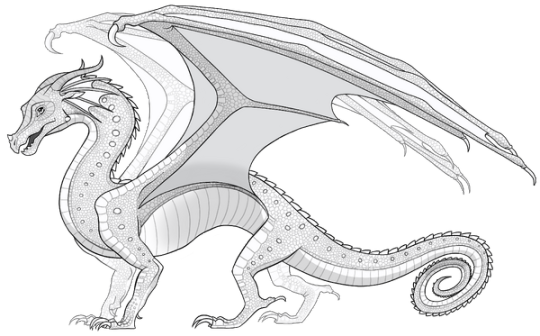



This is a RainWing, or rainforest dragon. Their scales can be any color of the rainbow. They can camouflage, have prehensile tails, and can shoot shoot acidic venom from their front fangs, which only a relative's can neutralize. They live in a hidden city among the trees of the Rainforest Kingdom. Their diet consists of mainly fruits, such as pineapples, coconuts, bananas, oranges, mangoes, strawberries, blueberries, etc., but they if it came down to it, they could eat meat, they just prefer not to. Their names can be such as:
Fruits: Pineapple, Coconut, Mango...
Rainforest plants: Liana, Mangrove, Bromeliad, Orchid...
Rainforest animals: Python, Bullfrog, Tamarin, Kinkajou...
Grand or beautiful adjectives: Handsome, Exquisite, Dazzling, Grandeur, Glory...
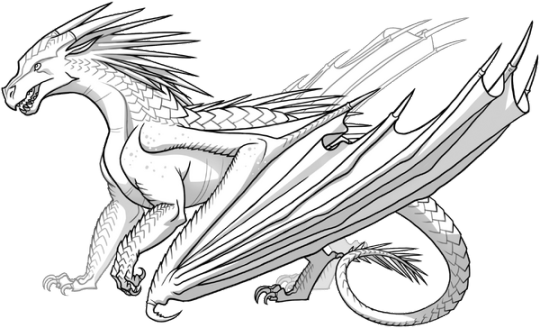

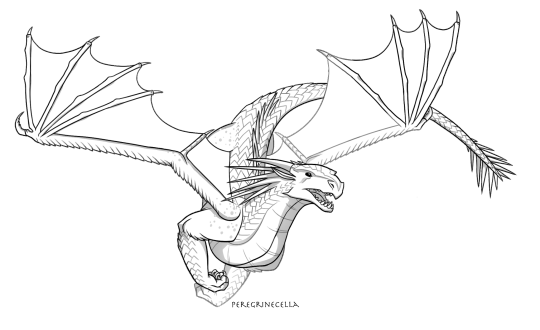

This is an IceWing, or ice dragon. They have pale white, pale blue, silvery, pale purple, or even opalescent scales. They can withstand freezing temperatures, withstand bright light, radiate a chill from their scales, have serrated claws, and can breathe frostbreath, which when it used on a dragon or plant, can freeze an area, and if untreated, will cause the area to blacken and die. They live in the tundras of the Ice Kingdom, and their diet consists of artic and antarctic animals, such as seals, whales, caribou, polar bears, and orcas, and have been known to eat moss and seafood such as crabs and fish. They have had a hierarchy, which is the Seven Circles for the nobility. They used to have animus dragons, but their last one eloped with a NightWing, and one of their eggs hatched the first NightWing animus (and the most dangerous one) Darkstalker. Their names can be such as:
Arctic and antarctic animals: Narwhal, Mink, Polar Bear, Caribou, Penguin...
Wintery conditions: Arctic, Permafrost...
Winter weather: Snowflake, Hailstorm, Blizzard, Whiteout...
White gems: Diamond, Crystal, Opal...
Ice formations: Glacier, Icicle...
Cold landscapes: Tundra, Fjord...
Words that mean white: Alba, Hvitur...
#honeycomb thoughts#platonic yandere marvel#yandere platonic marvel#platonic yandere xmen#yandere x-men#🐉wings of fire au#🥚tiny talons🐉 au#🥚tiny heir❄ au#🥚tiny sting🐝 au#🍷the heir of evil🐉 au#🍯honey and venom🧪 au
10 notes
·
View notes
Note
Assign cetaceans to your OCs?
How do you know all of these class terms of animals? Fancy
Arline Lanes: Narwhal!

Fox: Clymene dolphin

Carina Shepherd: Striped Dolphin

Dannie Karim: Atlantic spotted dolphin

Ryn Halvorsen: Harbour porpoise
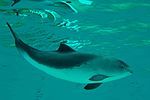
Willow Tree: Antarctic minke whale

Silas Petersson: Atlantic white-sided dolphin
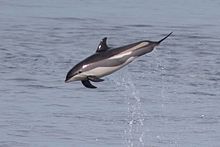
Pigeon: Common dolphin

Arith: Orca!
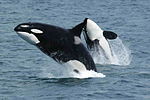
Iriel: Common bottlenose dolphin
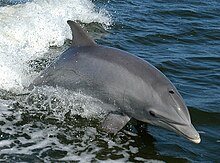
Kaia: Fin whale

Odel: Commerson's dolphin
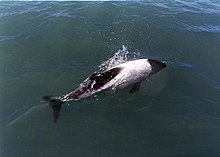
Eliška Hasek: Beluga
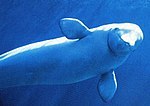
Marigold Rosales: Hourglass dolphin

Rosie Rosales-Maximoff: Dusky dolphin
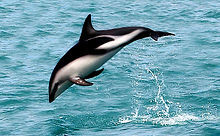
Allison Dahir: Fraser's dolphin

Lee Quinn: Common minke whale
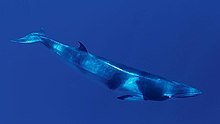
Jelaa Latka: Spinner dolphin

Van Kahl: Gray whale

#answered asks#pringle answers#practically an xman#arline the arcane oc#oc: fox#carina shepherd // beatrice maddison#dannie karim#ryn halvorsen#willow crazytree#silas petersson#nameless ghoul pigeon#pringles good omens ocs#eliška hasek#xmen oc au#lee quinn#jelaa latka#van kahl
6 notes
·
View notes
Text
Fascinating Facts About Whales on the Gold Coast You Need to Know
The majestic sight of whales on the Gold Coast draws thousands of nature enthusiasts each year. This stunning region in Australia offers one of the most exciting whale-watching experiences, thanks to its pristine coastline and clear waters. Understanding these incredible creatures enhances the magic of witnessing them in the wild. Here are fascinating facts about whales on the Gold Coast that everyone needs to know.

The Best Time to See Whales on the Gold Coast
The migration of whales on the Gold Coast typically occurs between May and November. During this period, thousands of humpback whales make their annual journey from the cold Antarctic waters to the warmer breeding grounds off the Queensland coast. The peak season is between June and October, where sightings are almost guaranteed.
Why the Gold Coast Is a Whale-Watching Paradise
The combination of deep waters close to shore and warm ocean currents makes the Gold Coast an ideal location to observe these marine giants. The whales often come within just a few kilometers of the coastline, offering an incredible view from both land and sea. The natural environment of the Gold Coast ensures minimal disturbance to the whales while allowing visitors an unforgettable experience.
Types of Whales on the Gold Coast
The most common species of whales on the Gold Coast is the humpback whale. Known for their acrobatics, humpbacks often breach, slap their tails, and showcase impressive displays. On rare occasions, visitors may also spot southern right whales, minke whales, and pilot whales migrating through these waters.
Humpback Whale Facts
Adult humpback whales can reach up to 52 feet in length and weigh around 30 to 40 tons.
Calves are born weighing approximately one ton and measure about 10 to 15 feet long.
Humpbacks are known for their unique songs, which can last for up to 20 minutes and travel vast distances underwater.
The Whale Migration Journey
The migration of whales on the Gold Coast spans thousands of miles. Humpbacks leave Antarctica in search of warmer waters to breed and give birth. The Gold Coast provides an ideal resting and socializing spot during their journey. Once the breeding season is over, the whales return south, often accompanied by their newborn calves.
Conservation Efforts for Whales on the Gold Coast
Australia has strict regulations to protect whales on the Gold Coast. Boats are required to maintain a safe distance from whales, and there are heavy penalties for disturbing these creatures. Whale conservation organizations continually work to monitor whale populations and ensure that the migration routes remain safe. Public education campaigns also help raise awareness about the importance of protecting these incredible animals.
What Makes Whale Watching on the Gold Coast Unique
Few places in the world offer such close and frequent encounters with whales in their natural habitat. Clear blue waters, mild weather, and breathtaking scenery make the experience even more memorable. The proximity of the whales to the shoreline allows for excellent sightings, even from popular beaches and headlands like Burleigh Heads and Point Danger.
Interesting Whale Behaviors to Watch For
While observing whales on the Gold Coast, several behaviors captivate visitors:
Breaching: Whales leaping out of the water and crashing back down is one of the most dramatic sights.
Tail Slapping: This involves slapping the tail flukes on the surface of the water, possibly to communicate or dislodge parasites.
Spy Hopping: Whales raise their heads vertically out of the water to look around.
Pectoral Fin Slapping: Large pectoral fins are slapped against the water’s surface, often as part of social behavior.
Whale Watching Tips for the Best Experience
To get the most out of observing whales on the Gold Coast, consider these tips:
Visit between June and October for the highest chance of sightings.
Early morning or late afternoon tours often provide the calmest waters.
Choose a vantage point from land for a budget-friendly option — places like Currumbin Rock and Point Danger offer excellent views.
Bring binoculars and a camera with a zoom lens for capturing unforgettable moments.
Dress in layers and wear sun protection, even during cooler months.
Final Thoughts
The presence of whales on the Gold Coast is not only a remarkable natural phenomenon but also a testament to successful conservation efforts and the beauty of Australia’s marine biodiversity. Whether witnessed from the shore or a boat, these gentle giants inspire awe and wonder. Anyone visiting the Gold Coast during the migration season has the chance to be part of one of nature’s most incredible displays.
For those seeking an extraordinary encounter with nature, watching whales on the Gold Coast is an experience that will remain unforgettable.
0 notes
Text
Scientists unsure what prompted juvenile whale to leave icy southern waters for warmer shallows, but ‘it may be a case of mis-navigation’
0 notes
Text
What Types of Whales Can Be Seen on the Gold Coast?
The Gold Coast is known for its beautiful beaches, vibrant lifestyle, and natural beauty, but one of its most captivating features is the opportunity to spot majestic whales. Every year, these incredible marine mammals migrate along Australia's coastline, making the Gold Coast an ideal location for whale watching. The region attracts a variety of whale species, providing enthusiasts with an unforgettable experience.
In this article, we will explore the different types of whales that can be spotted on the Gold Coast, their migration patterns, and the best times to view these magnificent creatures.

Whale Migration on the Gold Coast
The annual migration of whales along the Australian coast is a spectacular event. From May to November, whales make their way from the cold waters of the Antarctic to the warmer, tropical waters of northern Australia to breed and give birth. This migration brings several whale species along the eastern coastline, with the Gold Coast being a prime spot for viewing.
During this period, whale watchers can enjoy the sight of humpback whales, orcas, and sometimes even smaller species like the minke whale. The waters off the coast of the Gold Coast provide a safe passage for these animals, and the region's diverse marine ecosystem offers the perfect environment for observing them in their natural habitat.
Types of Whales Visible on the Gold Coast
1. Humpback Whales
The most commonly sighted species of whale along the Gold Coast is the humpback whale. These magnificent creatures are known for their size and the distinctive hump on their backs. Humpback whales are known for their long migrations, which can span over 10,000 kilometers each year, traveling from the cold waters of the Antarctic to the warmer waters of Australia.
Humpback whales are easily identifiable by their acrobatic behaviors, such as breaching (jumping out of the water) and tail-slapping. These behaviors make them a favorite among whale watchers. Between June and November, the Gold Coast becomes a hotspot for spotting humpbacks as they make their way north to breed and then return south with their calves.
2. Orcas (Killer Whales)
While less common, orcas, also known as killer whales, can occasionally be spotted off the Gold Coast. These highly intelligent and social animals are part of the dolphin family but are larger and have a more robust build. Orcas are known for their striking black-and-white coloration and are apex predators in the marine food chain.
Orcas are generally found in deeper waters, but their migratory routes sometimes bring them close to the Gold Coast, where they may hunt for seals, fish, or even other whales. Though sightings are rare, orcas are one of the most awe-inspiring animals to encounter during whale watching season.
3. Minke Whales
The minke whale is one of the smaller species of baleen whales but still a magnificent sight to behold. Minke whales are often spotted on the Gold Coast, particularly during the early part of the migration season. They are typically shy and elusive, making sightings less frequent compared to humpback whales, but when spotted, they offer a unique and peaceful whale-watching experience.
Minke whales are known for their streamlined bodies and swift swimming abilities. They are often seen swimming alone or in small groups, feeding on krill and small fish in the waters off the Gold Coast.
4. Southern Right Whales
Although not as frequently seen as humpback whales, southern right whales are another species that can be spotted off the Gold Coast. These whales are larger than humpbacks and are easily recognizable by their lack of dorsal fin and the rough patches of skin, known as callosities, on their heads. Southern right whales migrate along the eastern coast of Australia, and sightings have been reported in the waters near the Gold Coast, particularly in the later months of the migration season.
Southern right whales are known for their slow, graceful movements, and their tendency to stay close to the shore makes them a popular sight for whale watchers. However, due to their low numbers and shy nature, they are less commonly seen than humpbacks.
Best Time to See Whales on the Gold Coast
The prime whale-watching season on the Gold Coast spans from May to November, with the peak months being June through October. During this time, the Gold Coast is a popular destination for whale watchers, offering numerous tours and vantage points for observing these majestic animals.
May to June: Early in the season, migrating whales can be seen moving north along the coast, heading toward warmer waters to breed.
July to September: This is the peak of the migration season, and the Gold Coast sees a high number of whale sightings. Humpback whales, in particular, are abundant during this time.
October to November: As the whales start their journey back south with their calves, sightings of humpback whales continue, although in slightly fewer numbers compared to the mid-season.
Whale Watching Locations on the Gold Coast
The Gold Coast offers several locations where whale watchers can enjoy a spectacular view of these marine giants. Popular whale-watching spots include:
Point Danger: Located at the southern tip of the Gold Coast, Point Danger offers stunning views of the Pacific Ocean and is an excellent location for spotting migrating whales.
Burleigh Heads National Park: A scenic coastal park with great viewing spots, Burleigh Heads is another top location for whale watching during the season.
Surfers Paradise: Known for its bustling atmosphere, Surfers Paradise also offers whale-watching cruises that take visitors out to sea for a closer encounter with the migrating whales.
Conclusion
The Gold Coast is a prime location for experiencing the awe-inspiring sight of migrating whales. Whether it's the playful humpback whales, the elusive minke whales, or the rare southern right whales, the region offers something for every whale enthusiast. By visiting during the peak migration months and choosing the right viewing locations, whale watchers can experience one of nature's most incredible spectacles right here on the Gold Coast.
0 notes
Note
more because I didn't look at the graphic first, this is showing several large whales but not a) all the baleen whales or b) only baleen whales (the sperm whale is toothed). missing species are northern Pacific right whale — which have an extremely low population, bryde's whale, omura's whale, sei whale, rice's whale, the common and antarctic minke whales, and the pygmy right whale.
How do the many species of baleen whales coexist in the same ecological niche without competing with each other?
the ocean is EXTREMELY fucking big

580 notes
·
View notes
Photo

Antarctic minke whale “Balaenoptera” bonaerensis
Observed by natforlife, CC BY-NC
#Balaenoptera bonaerensis#Antarctic minke whale#Cetacea#Balaenopteridae#cetacean#whale#Antartica#Southern Ocean#sea ice
105 notes
·
View notes
Text
Friday, February 16 - Cievra Cove and Mikkelson Harbor
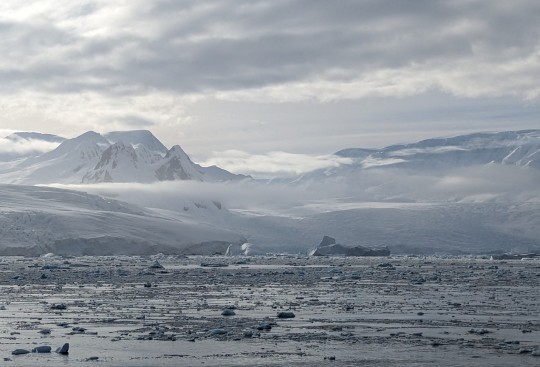
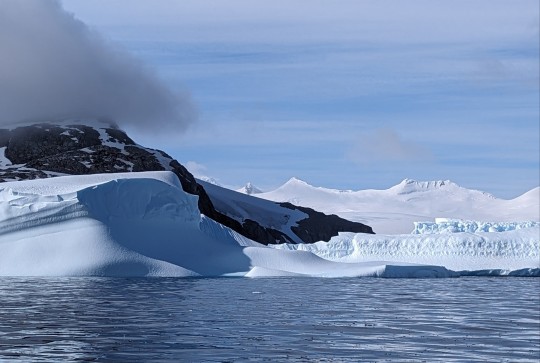
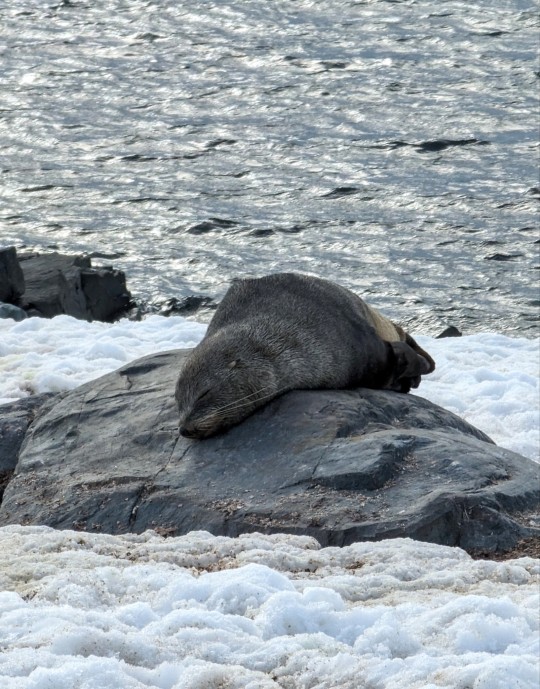
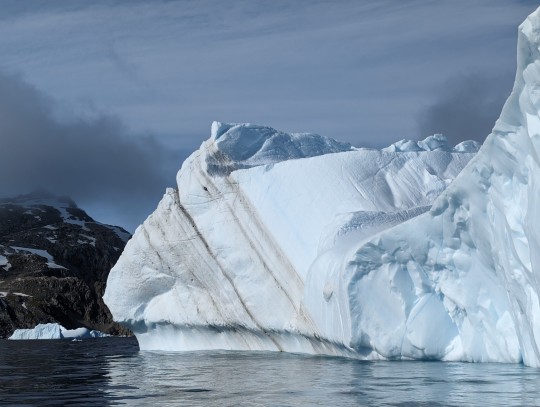
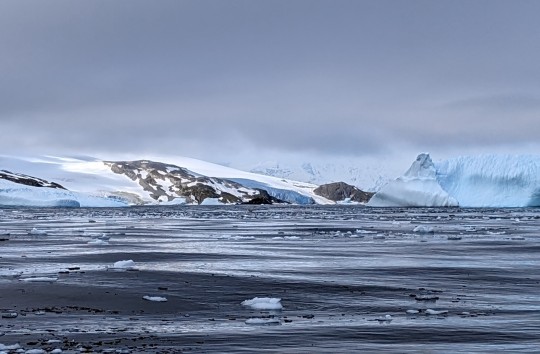
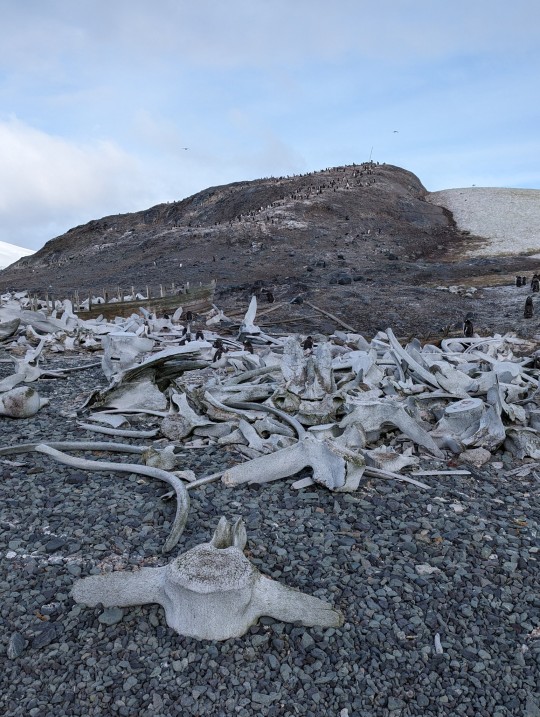

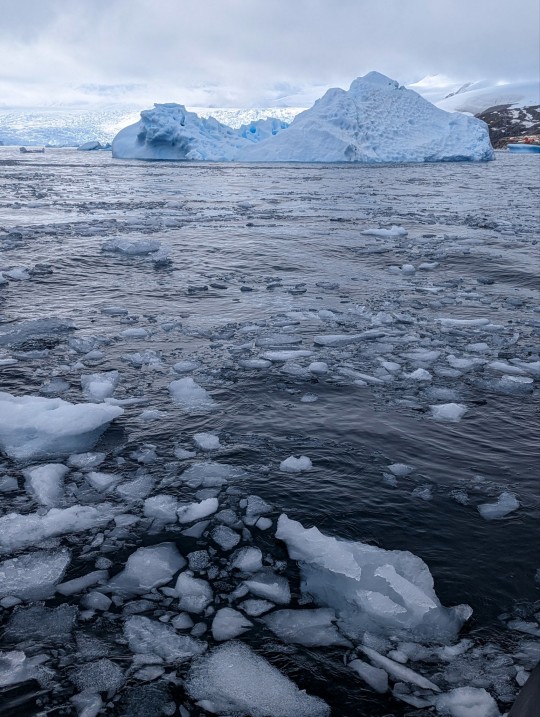
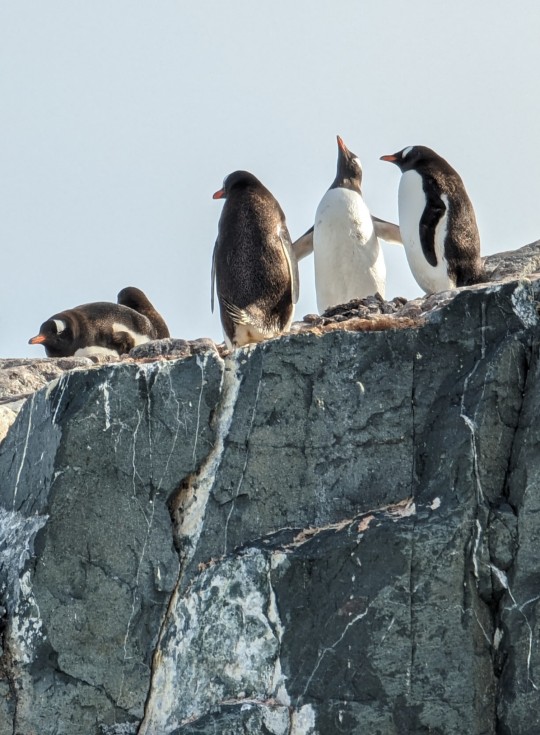
We had another gorgeous day, with mixed clouds and sun, and temperatures around freezing. Our first activity was Zodiac cruising in Cierva Cove, which has an island in the middle aptly named Penguin Island. This is host to a large colony of Chinstrap penguins, which were a little far away for good phone pictures, but were extremely busy. There were still some almost grown chicks still around, as well as molting adult birds, so there was lots to see.
We are further south now and the bergs that have calved off the glaciers here are bigger and take on fanciful shapes. Some show the dirty layers from the glaciers, while others have been melted into caves and holes, and others show evidence of repeated rolling and small collapses. As our guide today, Udo, said, most people only go into an ice cave once.
There is a small Argentinian research base behind Penguin Island, optimistically called "Primavera". Several of their boats launched about the time we went by, and drove past us quickly. We were a bit more careful, as there is a lot of floating ice that makes for beautiful photos, but is hard on propellers.
Once everyone was back on board we headed over to our landing site for today - Mikkelson Harbor. It was sunny and warm enough for several of us to have lunch on the back deck, and as we left the cove, Russ and I saw a couple of Minke whales, followed later by a Humpback.
Mikkelson Harbor was used for many years by the whalers since it is about the only flat beach type area for miles around. It is on a very small island surrounded by glaciers on three sides, and has a Gentoo penguin colony. Unlike on Half Moon Island, where the only Gentoos were a few molting adults, here there are still a number of chicks. We were able walk up to a good vantage point on the island, and watched the penguins for a while (lots of opportunities to photograph parents feeding chicks), before heading down and around to some sleeping seals - about four Weddell Seals and one Antarctic Fur Seals. They were all zonked out, although occasionally one would do a stretch. Weddell seals are considered "true seals" and keep warm with their thick layer of blubber, while the fur seals have exterior ears, large forelegs, keep warm with their thick fur, and are more closely related to sea lions.
The beach here is littered with whale bones from the previous century where the whalers would drag the whales, flense and butcher them, leaving the rest of the carcasses to the birds, who picked the bones clean. There is also a boat still here - another testament to an industry thankfully in the past. Down here on the beach were lots of molting Gentoo adults, as since they are fasting and using a lot of energy keeping warm without their old feathers, there is no reason to waddle up the hill like the breeding pairs.
We usually have about an hour to hour and a half on shore, and our Zodiac rides are about an hour, although our guide this morning took us further and we were gone over 1-1/2 hours. In that time we can see plenty, although we could spend hours just watching the penguins. The locations are tightly controlled and reserved so only one ship is at any place at one time. Our expedition leader was able to pick up Mikkelson Harbor and add it because of a cancellation. So we were surprised after dinner to see two other ships nearby - one traveling our way and the other heading the other direction. Most of the time it is like our private Antarctica.
We had our recap, short educational segments and briefing for tomorrow in the early evening (they have mostly been before lunch), so delayed going to the more casual restaurant until a bit later, stopping up in the Club to listen to the live music and watch the ice go by. It is a small ship, but there can be a little crush in the eating venues when everyone is released at once.
Tomorrow we have an early landing (starting at 7 AM for some), and then an evening landing that our Expedition leader just picked up for a spectacular spot. The ship that has that "anchorage" during the afternoon is our sister ship, the Pursuit, so we will be in communication with them and may be able to start earlier than the scheduled first group at 6PM. We stayed here at Mikkelson until after 7 tonight because of the submersible schedule, but it was lovely just to watch the light change on the snow and ice. We are almost two months from the Solstice now, and although the daylight hours are still long, it is getting dark by 10PM or so.
0 notes
Text
Alejandro and Rodolfo being rescue/rehabilitators, and they own a rescue center in Mexico. Governments/forces are trying to buy them out for experimentation, but they're standing firm on their beliefs. These creatures exist because they exist just like anyone else, and sometimes they need a bit of help, they're not something to be oggled at. Graves being there on a foreign research trip and taking too many notes, too many videos. Eventually, one of the hybrids that they were rehabilitating, they called him Roach, who was injured after being too close to a detonated depth charge, (I'm thinking maybe he's a minke whale hybrid? I like them they're funky) and it's time they release him back into the proper waters. Sure, it's a process, but it's necessary.
They meet up with a few friends they know, a couple researchers doing a few studies and observations of marine life in the antarctic, and decide to inform them about the minke whale rescue. Now, Price, Laswell, and Nikolai, the head researchers, have a perfect idea on how to get this Minke whale hybrid readjusted to underwater life after a few years of human contact. They've been monitoring two other hybrids, nicknamed Ghost and Soap, an orca hybrid and a leopard seal hybrid, an unlikely pair, and decide that the minke whale would fit in. At first, Rodolfo, the veterinarian, was concerned about the predatory habits of an orca against a minke, but Laswell showed proof of an almost mutualistic bond between the seal and orca, and reluctantly, Rodolfo gave in.
There's a furred seal hybrid outside the door when they make up their mind. He's a nice looking creature with soft fur and rich skin, and stunning brown eyes. He made a few barking sounds at them, nudging the two as his ears flattened against his head. Alejandro crouched down to attempt to make conversation, and Price informed them both that this hybrid was nicknamed Gaz, who had developed an attachment to the base after release, and didn't seem to leave them alone. But nobody really was complaining, he was a kind hybrid who didn't understand why the researchers did not want dead squid or octopus every morning.
There was a horn off in the distance and the group perked up a little bit, but Gaz's ears still lay flattened against his head. After a moment, he hurries off and disappears into icy water. In the distance, they see a transport boat. Apparently, it contained the rest of their supplies for the season, along with a few other researchers from around the world. Apparently, this was a popular destination.
On the boat were three new people. One named Alex Keller, an American marine biologist, who was working on his marine rehabilitation book. The second named Farah Karim, a strong-headed environmentalist who was determined to show the world that hybrids were not something to be afraid of. The third, named Philip Graves, a researcher from a private company. They must've been rich, and highly suspicious, because with one Google of the company name, nothing was found. Rodolfo had a sinking feeling it was a government agent, but Alejandro assured that it was a researcher that they had known. After all, it's the same kid who visited their rehabilitation center a few years ago, before the American media picked up a false ideology about hybrids, then creating the whole stigma.... the kid that took so many notes. He was only interested in the benefit of the hybrids. He did say he was a researcher, right?
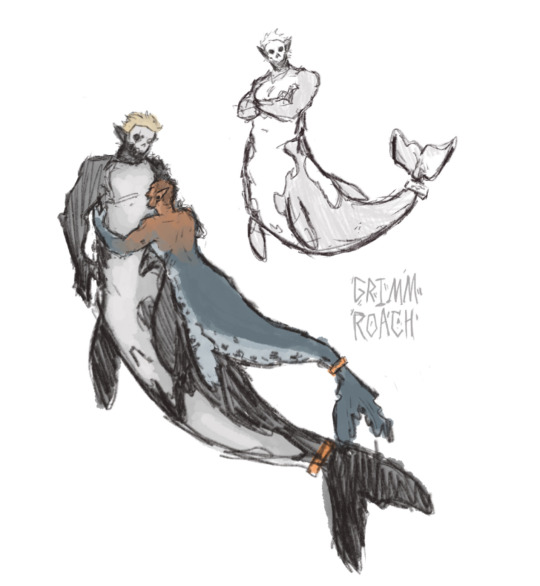
orca!ghost + leopard seal!soap
#the benefit of the hybrids has a double meaning#he can benefit FROM them#ghoap#ghoap au#simon ghost riley#john soap mactavish#rodolfo x alejandro#rodolfo parra#alejandro vargas#kyle 'gaz' garrick#kyle garrick#i really like marine biology can you tell
3K notes
·
View notes
Photo
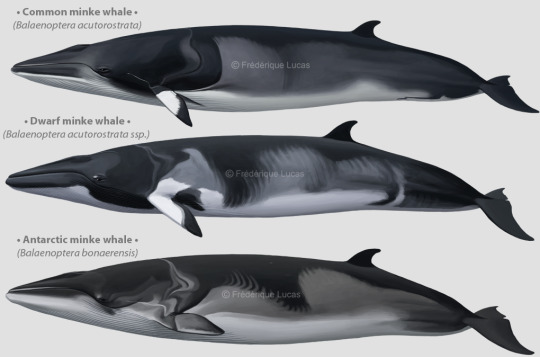
A multitude of minkes
Sorry for the long quiet here, guys. I’ve been very busy with my train driver’s license, as well as setting up a new aquarium and taking care of the residents. I haven’t been painting at all these months, but I’ll try to upload previously made art a bit more often!
Like this trio; as you may know I completed two pretty big commissions last year, and between them I got to paint all three species of minke whales again. The common minke I’ve painted several times before, the Dwarf and Antarctic not so much. The latter two are based on my previous paintings of them, so they may seen a bit familiar. I’m fascinated by the tiger stripes both possess. The Dwarf minke, though well known and vastly different looking from the Common minke, has yet to receive a scientific name. I hope you’ll enjoy these small but incredibly beautiful baleen whales.
#illustrations#scientific illustration#minke whale#dwarf minke whale#common minke whale#Balaenoptera acutorostrata#Antarctic minke whale#Balaenoptera bonaerensis#baleen whale#balaenopterid#digital animation
183 notes
·
View notes
Text

[ID: A pair of Antarctic minke whales from Endless Ocean 2. End ID.]
Antarctic minke whale from Endless Ocean 2 (2009)
21 notes
·
View notes